Yves GARY Hits: 3827
Category: 1903 : CHALLENGE N°12
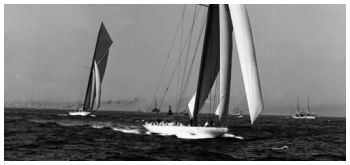 RELIANCE WINNER BY GOOD MARGIN
RELIANCE WINNER BY GOOD MARGIN Aug. 23, 1903 - A fine breeze and a good sea yesterday made the first real race between Reliance and Shamrock III. a splendid contest, and a bright ...
Aug. 23, 1903 - A fine breeze and a good sea yesterday made the first real race between Reliance and Shamrock III. a splendid contest, and a bright ...
... sun, a clear sky, and a great spectator fleet made it a remarkable spectacle. Reliance won by nine minutes, actual time, and her performance was quite equal to the promise she made in the unfinished race of Thursday, and Sir Thomas Lipton’s imagination, which in the false light of fond hope has seen the cup grow very large and near, must involuntarily have reverted to thoughts of a Shamrock IV.
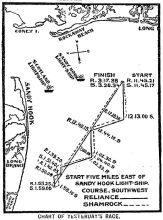 THE RACE IN DETAIL
THE RACE IN DETAILThe race was a fair, square, and conclusive test of the relative merits of the boats, and the Reliance was proved superior. True, the challenger sailed a good race, but she sailed a losing race. The yachts were at the Sandy Hook Lightship more than an hour in advance of the time set for the start, but the wind being from the southwest, a windward course could not be laid without intruding on private grounds between Elberon and Deal Beach.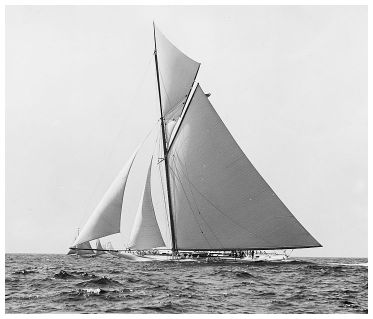 It was necessary, therefore, to shift the starting point five miles to the eastward of the lightship. As soon as the Regatta Committee became satisfied that the wind would hold in the southwest the change of starting point was announced by signal, and the Navigator steamed to the eastward, followed by the racers under sail, with the excursion fleet tailing on behind.
It was necessary, therefore, to shift the starting point five miles to the eastward of the lightship. As soon as the Regatta Committee became satisfied that the wind would hold in the southwest the change of starting point was announced by signal, and the Navigator steamed to the eastward, followed by the racers under sail, with the excursion fleet tailing on behind.
Arrived at a point about five nautical miles east half south from the Sandy Hook Lightship, and about twelve nautical miles due south of Little Inlet, at Rockaway, the tug Unique was anchored as a mark boat, and the Navigator took position on a line half a mile to the southeast. Soon afterward, Shamrock, which had been staggering visibly in the ten to twelve-knot breeze under her big club topsail, sent men aloft and brought the sail to the deck. A smaller sail had been bent to spars in the meanwhile, and was started on the way up as soon as the other could be freed of the halyards. The change was made with commendable alacrity. Barely five minutes elapsed between the striking of the first club and the sheeting home of the second. One must know the size and weight of the club topsail spars of these big racing yachts to appreciate the celerity of that work.
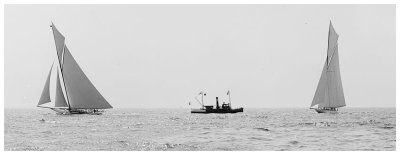 The tug John Scully was started off at 11:15 to log the course. The Coastwise was in position to serve as guide to the yachts when the preparatory signal was given at 11:30. Reliance, with boom off on the starboard hand, was at that time heading northwest and close to the Navigator at the leeward end of the line. Shamrock, also standing to the northwest, was about 200 yards astern of Reliance. The latter passed to the eastward of the committee boat, hauled up on the wind, and went off to the westward. Shamrock passed to the westward of the committee boat, then hauled also on the wind and followed the Reliance. They stood considerably to the westward of the line, Reliance leading. At 11:36 Shamrock jibed and stood back toward the mark boat. Reliance immediately followed suit and followed to windward of her wake. One minute before the warning signal, 11:40, she bore away and closed up a part of the gap between herself and Shamrock.
The tug John Scully was started off at 11:15 to log the course. The Coastwise was in position to serve as guide to the yachts when the preparatory signal was given at 11:30. Reliance, with boom off on the starboard hand, was at that time heading northwest and close to the Navigator at the leeward end of the line. Shamrock, also standing to the northwest, was about 200 yards astern of Reliance. The latter passed to the eastward of the committee boat, hauled up on the wind, and went off to the westward. Shamrock passed to the westward of the committee boat, then hauled also on the wind and followed the Reliance. They stood considerably to the westward of the line, Reliance leading. At 11:36 Shamrock jibed and stood back toward the mark boat. Reliance immediately followed suit and followed to windward of her wake. One minute before the warning signal, 11:40, she bore away and closed up a part of the gap between herself and Shamrock.
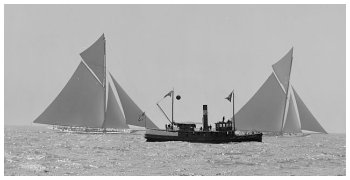 Thus they maneuvered about the mark boat until the time for the starting signal was near. That signal was to be given at 11:45. Shamrock, standing northward, with boom off to starboard, passed westward of the mark boat, jibed, and then stood for the line. Reliance jibed a few seconds later, and followed astern but to windward. As on Thursday, the yachts had kept well apart. There had been no jockeying and no attempt at interference of either with the other. It was gentlemanly maneuvering throughout, but Barr had kept a wary eye from first to last on the windward position. Not for a moment was he in danger of losing it. The last of the warning minutes had almost gone when Shamrock went on the starboard tack and stood for the line. She was well up at the windward end, and the Reliance was on her weather quarter, but she was too soon. She had to bear off and run down toward the committee boat Navigator. She was so close to it at gunfire that when she shot across the line she went through the smoke of the gun. Barr had timed his approach better. He sent Reliance across close to the mark boat at the windward end of the line, with a great burst of speed. There was only four seconds difference in the times of the start, but the Reliance, though behind, had more than that in the advantage of position. The official times of the start are: Shamrock III, 11:45:17; Reliance, 11:45:21.
Thus they maneuvered about the mark boat until the time for the starting signal was near. That signal was to be given at 11:45. Shamrock, standing northward, with boom off to starboard, passed westward of the mark boat, jibed, and then stood for the line. Reliance jibed a few seconds later, and followed astern but to windward. As on Thursday, the yachts had kept well apart. There had been no jockeying and no attempt at interference of either with the other. It was gentlemanly maneuvering throughout, but Barr had kept a wary eye from first to last on the windward position. Not for a moment was he in danger of losing it. The last of the warning minutes had almost gone when Shamrock went on the starboard tack and stood for the line. She was well up at the windward end, and the Reliance was on her weather quarter, but she was too soon. She had to bear off and run down toward the committee boat Navigator. She was so close to it at gunfire that when she shot across the line she went through the smoke of the gun. Barr had timed his approach better. He sent Reliance across close to the mark boat at the windward end of the line, with a great burst of speed. There was only four seconds difference in the times of the start, but the Reliance, though behind, had more than that in the advantage of position. The official times of the start are: Shamrock III, 11:45:17; Reliance, 11:45:21.
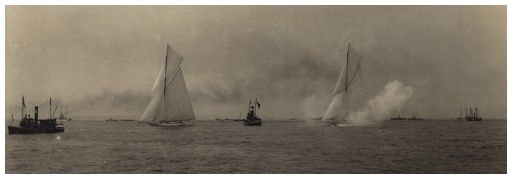 And so the great race began. The wind had freshened perceptibly in the last quarter of an hour, and Shamrock crossed the line without any jibtopsail or any apparent preparations to set one. Reliance was sending a baby up in stops as she crossed, and at 11:47:15 it was broken out. If the challenger's skipper had intended to set a jibtopsail he was dilatory in doing it; if he had not so intended he was quickly moved to change his mind, for at 11:49 his jib-topsail was aloft. And now that the yachts were straining to their work it, was noticeable that, despite her inferior sail spread, Shamrock was heeling considerably more than her rival. At times she lay down until solid water seemed to be rolling over her lee rail. The Reliance also lay over with the harder puffs, but not so much as Shamrock. Plainly the American boat was able to carry her sail the better, notwithstanding that she had more of it to carry.
And so the great race began. The wind had freshened perceptibly in the last quarter of an hour, and Shamrock crossed the line without any jibtopsail or any apparent preparations to set one. Reliance was sending a baby up in stops as she crossed, and at 11:47:15 it was broken out. If the challenger's skipper had intended to set a jibtopsail he was dilatory in doing it; if he had not so intended he was quickly moved to change his mind, for at 11:49 his jib-topsail was aloft. And now that the yachts were straining to their work it, was noticeable that, despite her inferior sail spread, Shamrock was heeling considerably more than her rival. At times she lay down until solid water seemed to be rolling over her lee rail. The Reliance also lay over with the harder puffs, but not so much as Shamrock. Plainly the American boat was able to carry her sail the better, notwithstanding that she had more of it to carry.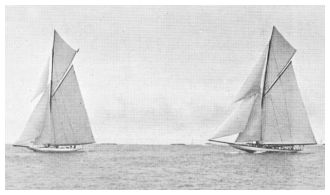
It was a stirring picture of a “wet sheet and a flowing sea.” The wet decks glistened in the sunlight. Clouds of spray flew over the bows. Broad trails of foam followed astern. How were they doing relatively to each other? Upon the deck of the press boat, following behind, few even of the experienced watchers could answer the question with confidence. That both were sailing fast was evident. That the Reliance held to windward was generally conceded. As to which was ahead few were willing to venture an opinion. Yet close observation showed that the masts seemed about equal in height, Shamrock‘s perhaps a shade the higher, and as Reliance had the loftier mast, by the well known law of perspective, she must have been ahead as well as to windward.
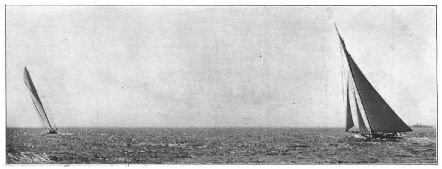 At 12:10:30 Reliance went on the port tack. Shamrock did not tack immediately. The advocates of Reliance claimed that she would not have tacked unless she were ahead. Shamrocks admirers asserted that she tacked only because she was behind. But the test of the question was Shamrock's failure to tack at once. If she had been ahead she would have lost no time in tacking to keep the Reliance under her lee. Reliance had been only 25 minutes and 9 seconds on the starboard tack, and in that comparatively short time she had taken the lead. Shamrock held the starboard tack two and a half minutes longer, or until 12:13.
At 12:10:30 Reliance went on the port tack. Shamrock did not tack immediately. The advocates of Reliance claimed that she would not have tacked unless she were ahead. Shamrocks admirers asserted that she tacked only because she was behind. But the test of the question was Shamrock's failure to tack at once. If she had been ahead she would have lost no time in tacking to keep the Reliance under her lee. Reliance had been only 25 minutes and 9 seconds on the starboard tack, and in that comparatively short time she had taken the lead. Shamrock held the starboard tack two and a half minutes longer, or until 12:13.
When she came about it was seen that she had taken in her jibtopsail. When it was done could not be noticed from the press boat, as she had been standing straight away from it at a distance of nearly two miles. At 12:14:35 the Reliance also took in her jibtopsail. The wind had increased in force to perhaps fifteen miles an hour, and in such a breeze, though it may be easily carried, a jib topsail is not of much assistance. Indeed, if anything, it is a hindrance, as it prevents the yacht from laying as close to the wind as she can without it.
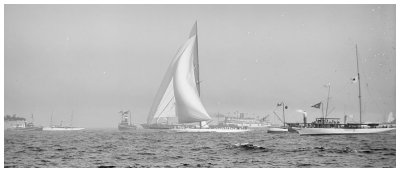 Reliance went on her second starboard tack at 12:40:15. She had then strung out a long lead on the Shamrock, but to many observers it seemed that the latter was so much to windward that she could not be crossed. A few contended otherwise, and the few were right. As the yachts approached each other excitement rose to the pitch of agitation. All doubts as to the relative positions of the yachts were set at rest permanently when the Shamrock went about at 12:-14:10. Then it was seen that the Reliance had the advantage in position.
Reliance went on her second starboard tack at 12:40:15. She had then strung out a long lead on the Shamrock, but to many observers it seemed that the latter was so much to windward that she could not be crossed. A few contended otherwise, and the few were right. As the yachts approached each other excitement rose to the pitch of agitation. All doubts as to the relative positions of the yachts were set at rest permanently when the Shamrock went about at 12:-14:10. Then it was seen that the Reliance had the advantage in position.
The second starboard tack was not as long as the first. Shamrock went to port at 1:02:30, and Reliance, well upon her weather bow, followed three seconds later. Wringe did not fancy staying under his enemy’s lee. He threw the Shamrock back to starboard at 1:03, almost before she had gathered way on the new tack. Barr gave himself no further concern about Shamrock, as he held on the port tack and sailed away from her. At 1:04:40 Shamrock returned to the port tack and followed in the Reliance's wake. It could now be seen how fast Reliance was dropping the Shamrock. Wringe stood it for twenty minutes without making a move, but at 1:24:40, the wind having softened a bit, he sent up a dark colored baby jibtopsail. 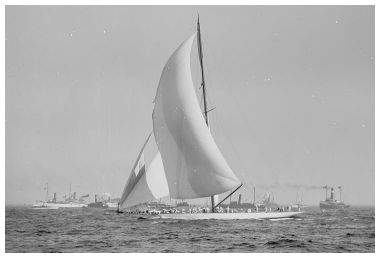 The example was too tempting for Barr to resist. He sent up a silvery sign of victory on the jibtopsail stay at 1:25:20. But the jib topsails were really not much of a help to either boat. They were constantly shaking and at times almost aback.
The example was too tempting for Barr to resist. He sent up a silvery sign of victory on the jibtopsail stay at 1:25:20. But the jib topsails were really not much of a help to either boat. They were constantly shaking and at times almost aback.
At 1:39:20 Reliance tacked to starboard, but only for a short hitch. At 1:42:05 she returned to port, and held that tack until 1:50:00, when she went to starboard, and headed straight for the mark. At 1:51:49 Shamrock, more than half a mile astern and also leeaward, likewise went to starboard, but she could not fetch, and was forced to tack once more, and make a short hitch to port for rounding. The Reliance, on the other hand, fetched the mark easily, and made a close turn.
Following are the times of the turn: Reliance, 1:55:17; Shamrock, 1:58:34.
The crew of Reliance showed to better advantage in setting the light sails after the turn. They got out the balloon jibtopsail in thirty-five seconds and the spinnaker in two minutes and thirty-five seconds. The Shamrocks balloon jib topsail was one minute in coming out, but the stops two-thirds of the way up the stay would not break out, and it was eventually necessary to take in the sail and reset it, which was not done until ten minutes after rounding. Shamrock‘s spinnaker was however, much more skillfully handled. 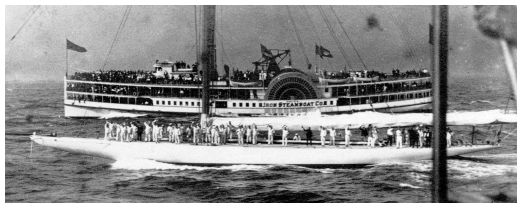 He was sheeted home two minutes and twenty-five seconds after the turn, or in ten seconds less time than that of the Reliance. Yet on the whole the advantage was decidedly on the side of Reliance’s men.
He was sheeted home two minutes and twenty-five seconds after the turn, or in ten seconds less time than that of the Reliance. Yet on the whole the advantage was decidedly on the side of Reliance’s men.
The run home was spectacular but uneventful. The yachts made a splendid marine picture with their bellying spinnakers and balloon jibtopsails. The Reliance drew steadily away from the Shamrock, showing plainly enough that in running she is Shamrock‘s superior in than quality. Reliance made fast though not record-breaking time on the run home. Her pace was a little under twelve knots. Nearly two miles of clear water lay between herself and the defeated challenger at the finish, which was made thus:

